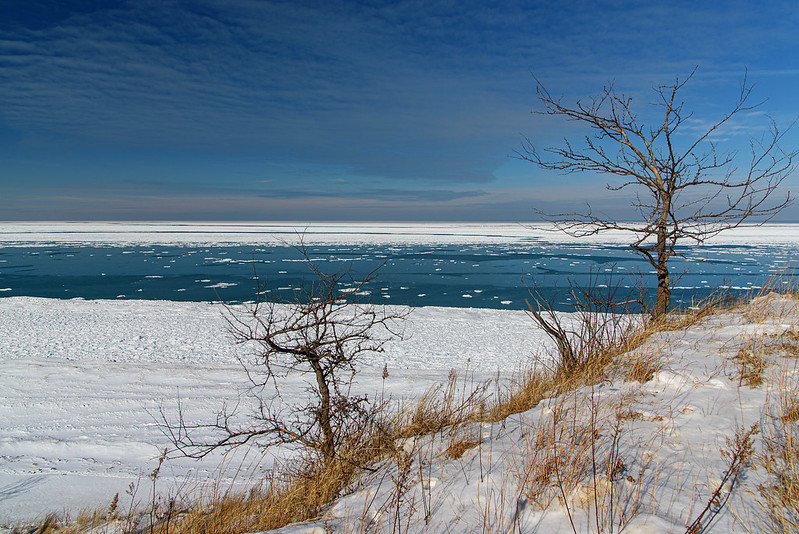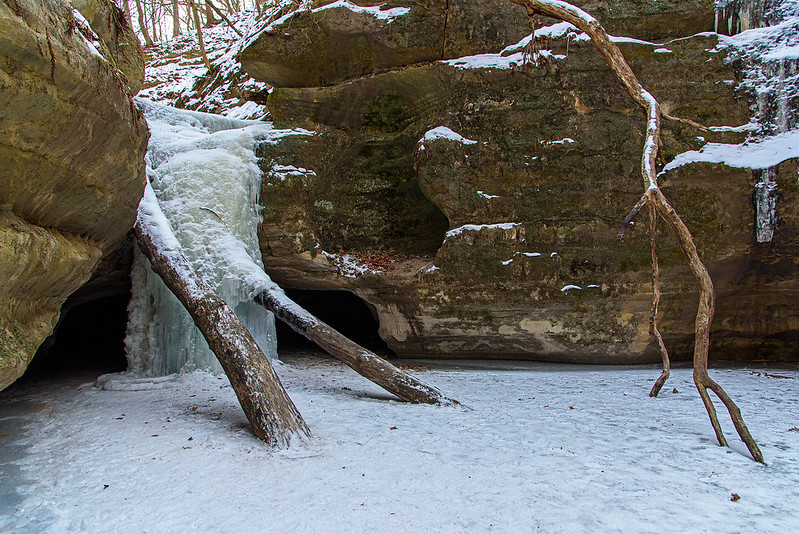
The Growing Ice on Lake Michigan

Deep in French Canyon

KasKaskia's Frozen Waterfall
 One of the smaller waterfalls and canyons of Starved Rock State Park is Kaskaskia. Located on a trail outside of the commonly visited area, it's grouped with two other interesting features of the park - Ottawa Canyon, and the Council Overhang.
One of the smaller waterfalls and canyons of Starved Rock State Park is Kaskaskia. Located on a trail outside of the commonly visited area, it's grouped with two other interesting features of the park - Ottawa Canyon, and the Council Overhang. The Ice Curtain

The Frozen Waterfall of Ottawa Canyon
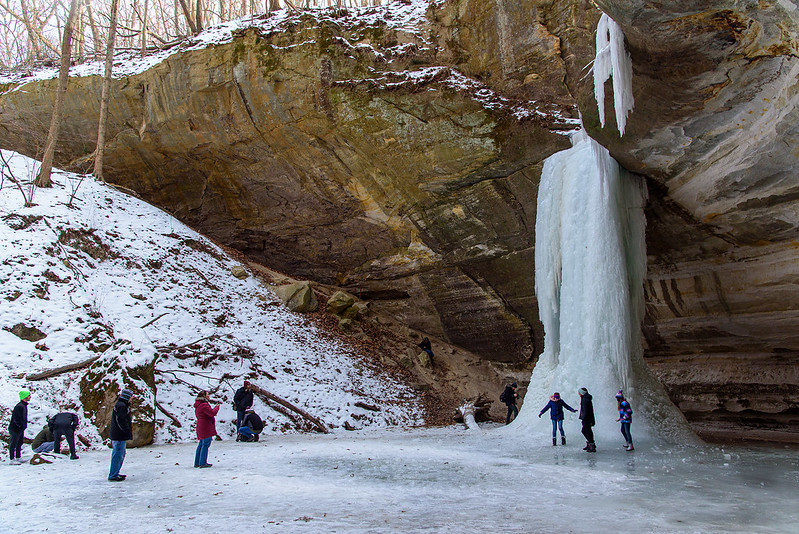
Located in a blind canyon, the waterfall of Ottawa Canyon dramatically reveals itself as you walk down the canyon. This year was probably the most crowded I've ever experienced the canyons in winter. It was certainly a nice day for winter - temperatures in the 20's and sun - and it was a weekend. I generally visit these canyons on weekdays to avoid so many people, but it's really nice to see families visiting natural sites instead of looking at them on the internet.
The Cold beach

The Dune Point
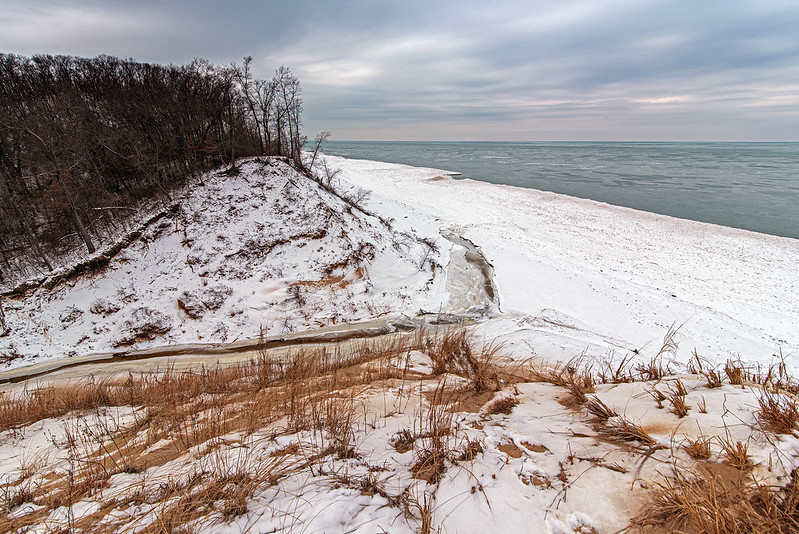
I suspect in a few more days the ice will form almost as far as the eye can see; it's so interesting to visit in the winter to see these changes. The lake looks more like the Arctic Ocean when it freezes up.
Contemplating

On the Tallest Dune

Central Beach in Early Winter

Ice Formations Along the Shore
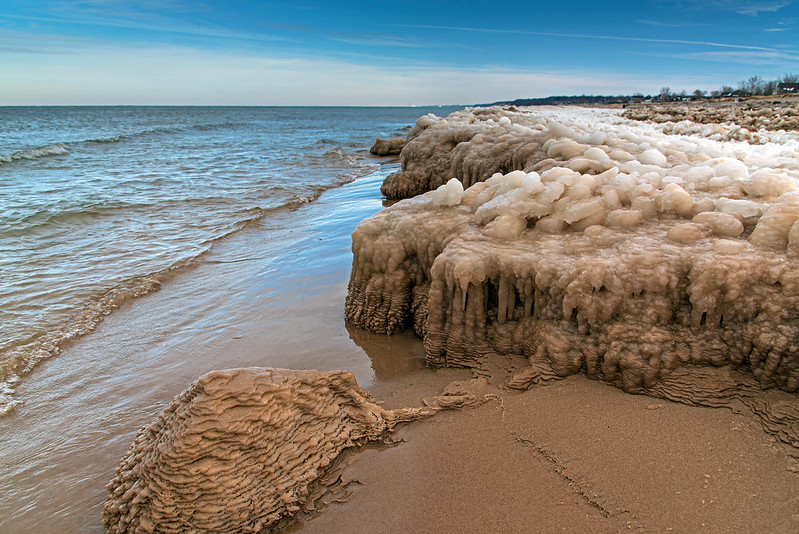 The cold weather begins to build up some shelf ice along the shore of Lake Michigan. At this early stage, the ice has not yet formed a shelf, and is completely attached to the land, so it's still safe to explore. In a few days, it will begin to form over the water, and that will be dangerous to venture onto.
When the waves begin to mound up the floe ice and ice chunks floating in the lake, the shelf ice will begin to pile up into mounds reaching 15 or 20 feet high. Before that, the ice now forms intricate shapes as the water flows back and forth on the beach. The formations created look a lot like stalactites and stalagmites in caves. I suppose both features are created in a similar manner, only the ice is fast and seasonal, while the limestone formations take thousands of years to form.
The cold weather begins to build up some shelf ice along the shore of Lake Michigan. At this early stage, the ice has not yet formed a shelf, and is completely attached to the land, so it's still safe to explore. In a few days, it will begin to form over the water, and that will be dangerous to venture onto.
When the waves begin to mound up the floe ice and ice chunks floating in the lake, the shelf ice will begin to pile up into mounds reaching 15 or 20 feet high. Before that, the ice now forms intricate shapes as the water flows back and forth on the beach. The formations created look a lot like stalactites and stalagmites in caves. I suppose both features are created in a similar manner, only the ice is fast and seasonal, while the limestone formations take thousands of years to form.
 In this small formation, almost every layer can be seen from the ground up, almost like a topographical map. These same layers can be seen all around the shore at this time, but will eventually be covered in large chunks of ice and snow. Only time will tell if the shelf ice builds hundreds of feet out into the lake, or if it will remain as is for the rest of the winter.
In this small formation, almost every layer can be seen from the ground up, almost like a topographical map. These same layers can be seen all around the shore at this time, but will eventually be covered in large chunks of ice and snow. Only time will tell if the shelf ice builds hundreds of feet out into the lake, or if it will remain as is for the rest of the winter.
Haunting Ice
 What was a bright, sunny day as we arrived at the St. Joseph, Michigan lighthouse, turned to an overcast winter day quite quickly, and dramatically. In fact, the fleeting transition between sun and clouds lasted only a moment or two.
An overcast day generally provides very flat light, no real bright spots, no dramatic shadows. Compare that to a sunny day where the dynamic range in light is extreme from sun to shadow. When the clouds rolled in, they blocked most of the sun quickly, but the last few rays of sun illuminated the ice against the dark clouds and water. This created a dramatic, haunting look and feel to this image.
What was a bright, sunny day as we arrived at the St. Joseph, Michigan lighthouse, turned to an overcast winter day quite quickly, and dramatically. In fact, the fleeting transition between sun and clouds lasted only a moment or two.
An overcast day generally provides very flat light, no real bright spots, no dramatic shadows. Compare that to a sunny day where the dynamic range in light is extreme from sun to shadow. When the clouds rolled in, they blocked most of the sun quickly, but the last few rays of sun illuminated the ice against the dark clouds and water. This created a dramatic, haunting look and feel to this image.
Ice Around the Pier
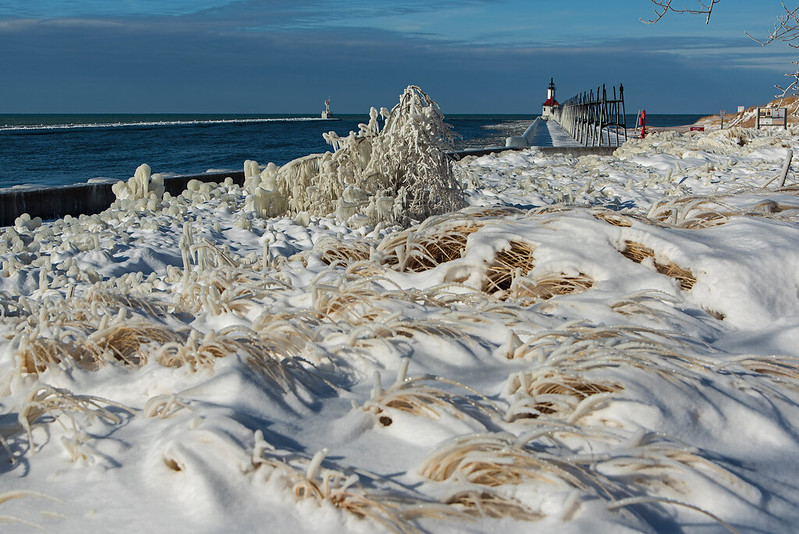
The "Hoodoos" of St. Joseph Michigan

The Ice is Beginning to Form

The new year brought some frigid weather to the southern Lake Michigan area, enough to begin the creation of some thick ice on the pier and catwalk of the St. Joseph, Michigan lighthouse. Typically, the ice begins to form much earlier in the season - sometimes in late November - but this winter, conditions weren't right until now.
Conditions include very cold temperatures, winds high enough to churn up waves that crash into the pier and lighthouse, and a liquid lake (not frozen yet) so waves can build up. A layer of ice on the lake prevents the water from splashing up, so later in the winter when the lake usually freezes over, ice rarely builds on the lighthouses.

While the ice hasn't yet covered the lighthouse, it is beginning to freeze the surfaces of the pier, railings, and catwalk. The ice on the railings is already about two feet thick may continue to build depending on how conditions are in the future.
Many years ago, winters along the Lake Michigan shoreline were generally lonely, very few people ventured to view the lighthouses or ice along the shore. In recent years, however, crowds of people brave the cold weather to experience the ice formations. As long as the everyone keeps off the ice, it's a great thing to see.
Autumn Hike on the Boardwalk
 This Fall season was relatively warm and dry, so the thought was that the leaves would drop early and without much color. As it turns out, the color was great, it was just delayed a few weeks. Visiting the Chellberg Farm trails at the Indiana Dunes National Park has become a tradition in the Fall, and it never disappoints. This area has scores of maple and beech trees that turn golden in autumn, and the rolling landscape provides the perfect setting for a hike.
Boardwalks and stairs provide relatively easy access through the deep gullys of this area. Even in the rain, hikers can enjoy the landscape without too much mud or overflow of streams.
This Fall season was relatively warm and dry, so the thought was that the leaves would drop early and without much color. As it turns out, the color was great, it was just delayed a few weeks. Visiting the Chellberg Farm trails at the Indiana Dunes National Park has become a tradition in the Fall, and it never disappoints. This area has scores of maple and beech trees that turn golden in autumn, and the rolling landscape provides the perfect setting for a hike.
Boardwalks and stairs provide relatively easy access through the deep gullys of this area. Even in the rain, hikers can enjoy the landscape without too much mud or overflow of streams.
 On the day of this hike the parking area was overflowing with cars, and the remote lot was being used. Surprisingly, these trails were almost empty; I wonder if visiters only knew about the short trail near the sugar shack and behind the farmhouse. Venturing past the barns and field, one finds the trail that wanders through these rolling, wooded dunes. There are a few trails that total about four miles (maybe more if you wander off toward other parts of the park), but this trail is about a mile loop. It's well worth exploring any time of year, but especially in the Fall.
On the day of this hike the parking area was overflowing with cars, and the remote lot was being used. Surprisingly, these trails were almost empty; I wonder if visiters only knew about the short trail near the sugar shack and behind the farmhouse. Venturing past the barns and field, one finds the trail that wanders through these rolling, wooded dunes. There are a few trails that total about four miles (maybe more if you wander off toward other parts of the park), but this trail is about a mile loop. It's well worth exploring any time of year, but especially in the Fall.
Autumn Gold

Walking through the sugar bush in autumn is amazing. The sugar bush is another term for a wooded area filled with maple trees used for maple sugar, and maple trees are known for their beautiful Fall color. One of my favorite places to explore in autumn is this particular sugar bush at the Chelberg Farm in northwest Indiana. The farm is part of the Indiana Dunes National Park, and a huge contrast to the beaches and lakeshore most people think of when they hear about the dunes.
These hills are dunes, long ago deposited by the wind and waves of a then much larger Lake Michigan. Over time, the grasses gave way to trees and the falling leaves helped create a more fertile soil to support more types of trees. The trees in this area were most likely planted by the early farming people like the Chelbergs to produce maple syrup.
The sugar shack can be seen at the top left of the image. This is where the maple sap was boiled until a good portion of the water evaporated, creating maple syrup. Tours of the sugar shack are given every March during the prime sap collection time.
 Hiking the winding, hilly trails of the sugar bush is absolutely beautiful in the Fall. This area has to be the most colorful of the entire park, and certainly worth the visit.
Hiking the winding, hilly trails of the sugar bush is absolutely beautiful in the Fall. This area has to be the most colorful of the entire park, and certainly worth the visit.
The Great Marsh

Developing Storms
 While kayaking at sunset, we watched two storms develop in the distance. The first was to the south, and the whispy clouds caught our attention at first. They soon developed into billowing clouds highlighted by the setting sun. After the sun sank below the horizon, the lake and trees darkened, but the storm clouds remained vibrant for quite some time. Lightning could be seen between the clouds, but the storm never came any closer to us.
This image was made with four individual photos stitched together side by side. I only had a 100mm lens with me, so a panoramic image was necessary to capture the entire cloud.
While kayaking at sunset, we watched two storms develop in the distance. The first was to the south, and the whispy clouds caught our attention at first. They soon developed into billowing clouds highlighted by the setting sun. After the sun sank below the horizon, the lake and trees darkened, but the storm clouds remained vibrant for quite some time. Lightning could be seen between the clouds, but the storm never came any closer to us.
This image was made with four individual photos stitched together side by side. I only had a 100mm lens with me, so a panoramic image was necessary to capture the entire cloud.
 At the very same time, to the east was an even larger storm developing. Again it was highlighted by the setting sun and never approached us, we remained dry the entire weekend. This panoramic image was created with eight separate images taken with a 100mm lens while sitting in a kayak on the lake.
Paddling any time during the day is great, but paddling at sunset and after dark is especially interesting. Our 11pm trips are always inspiring.
At the very same time, to the east was an even larger storm developing. Again it was highlighted by the setting sun and never approached us, we remained dry the entire weekend. This panoramic image was created with eight separate images taken with a 100mm lens while sitting in a kayak on the lake.
Paddling any time during the day is great, but paddling at sunset and after dark is especially interesting. Our 11pm trips are always inspiring.
Superior Mirage



